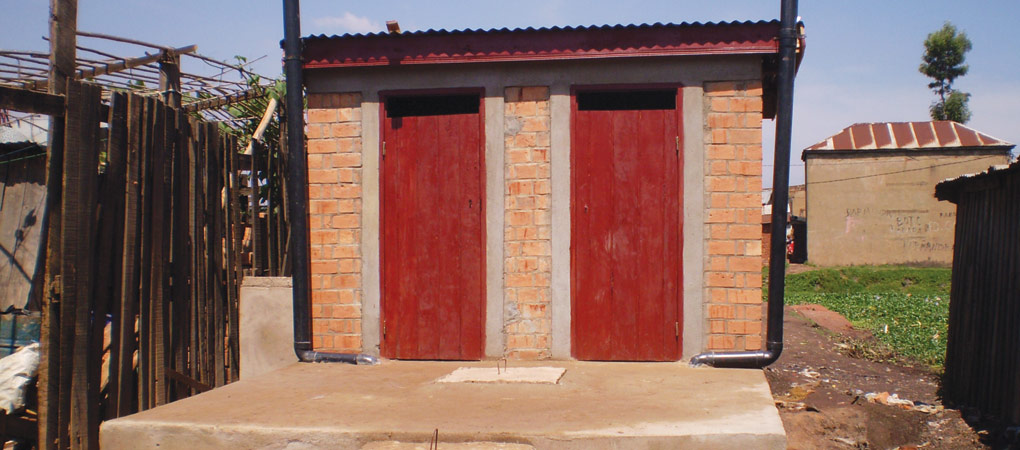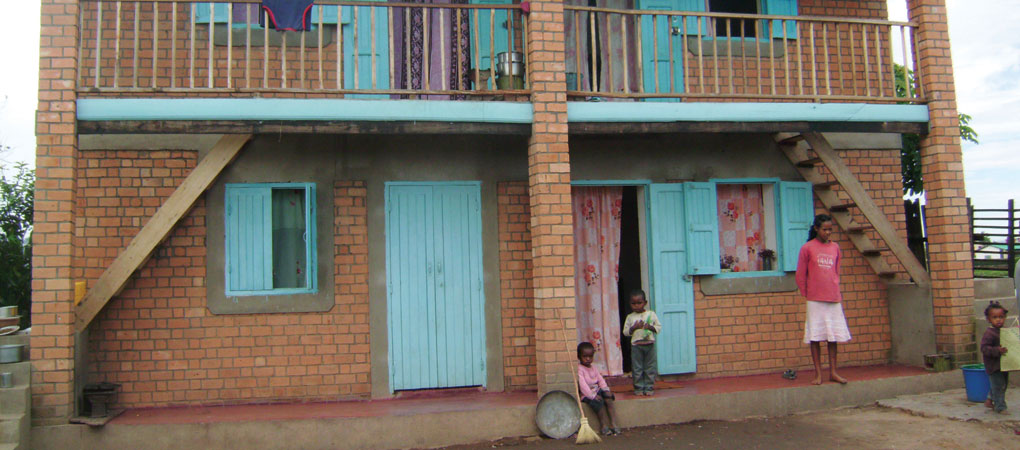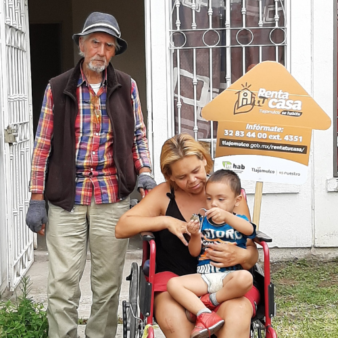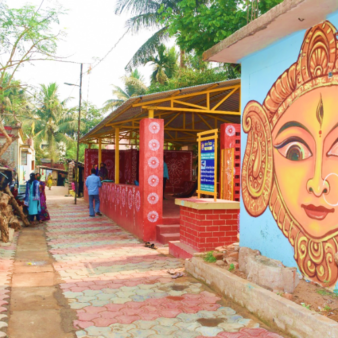In partnership with micro-credit institutions, Enda Océan Indien (Enda OI) established a savings scheme enabling families living in the Lower City of Antananarivo to save and borrow money for a new house and/or pit latrine. Enda OI supports the families throughout the process, from saving and adjusting to a new credit culture through to building and maintaining their new property.
Project Description
Aims and Objectives
The project aims to help inadequately housed families have access to decent housing and sanitation. It aims to improve the financial position of the families, and their security of tenure.
Context
The city of Antananarivo has a population of 1.5 million and is situated on the summit, slopes and surrounding plain of a long and narrow rocky ridge. The most affluent districts (the upper town) are situated on the higher land and overlook the marshy plains where there are dense informal settlements (the Lower City). Often subject to flooding, the Lower City has been described as a concentrated aggregate of all urban ills. The area has severe sanitation, hygiene and public health problems, as well as overcrowding, excessive traffic, dangerous pollution, precarious housing, and poor infrastructure all of which are exacerbated by rapid population growth (twentieth fastest rate of growth in the world). Eighty per cent of the Lower City population lives on less than one dollar a day and spending on food takes 70 per cent of income for most people.
Most families in the area have no access to a latrine and blocked open drainage channels frequently overflow during the rainy season flooding the Lower City districts with raw sewage. Only 20 per cent of houses have an indoor tap. Houses are very small, on average only 2m2 per person, constructed from rusted sheet metal roofs, temporary materials for walls and earthen floors. Fire is a common problem in the dense settlement. Building regulations stipulate minimum property dimensions, thereby allowing the city government to declare small houses illegal and clear them without compensation. Administrative procedures for proving land ownership to prevent such destruction are long and complex. Precarious employment, low and irregular incomes, poor access to health and education add to the physical problems faced by those living in the Lower City. Violent anti-government protests and the recent change of administration have generated political tension and instability.
Key features
Originally engaged in carrying out housing repairs and building extensions, Enda OI started to construct new houses in 2003, due to growing demand for housing and the increasing precariousness of existing houses. Enda OI only works with families that can prove ownership over their land or have sufficient papers to secure tenure, and its lawyers assist families with securing or proving these property rights. Enda OI provides strong social support throughout the project, helping families to become autonomous and face up to future challenges. It also works closely with the municipal authorities to raise awareness of the projects among residents, target the most vulnerable families and obtain intervention permits (in particular, permission to build houses that do not meet the minimum construction dimensions).
Typical plots sizes are 10m2 to 20m2 per household of five or six people and the new housing units typically measure 9m2 (2.5m x 3.5m) or 12m2 (3m x 4m). Many households share plots of land with other family members. Families must undertake to save for a year according to their economic capacity, before being eligible for credit for a house, with the line of credit being provided by a partner micro-credit institution. Enda OI acts as guarantor for the credit granted and provides support to families adjusting to a very new ‘credit culture’. A typical house costs US$ 1,412 and repayment of credit typically takes 48 months for a house and 12 months for a latrine. Repayment rates are high. The houses are built on the same site as the old house and Enda OI technicians help assess construction possibilities. The houses are built to a standard design to keep costs down, using mud bricks, sheet metal for the roofs and ferrocement of Makiplast (a plastic product) for the latrines which have individual septic tanks. The definition of savings capacity and thus the subsidy rate are based on a detailed analysis of income and household spending. Over 90 per cent of the individuals who benefit from the project have an income of less than US$ 380 per annum. At the end of the savings period, a subsidy is paid by Enda OI (up to 80 or 90 per cent of the construction costs) on behalf of families who have not been able to save/obtain credit for the total amount (only five of 69 families covered the total cost in 2010). On average, 50 per cent of construction costs are funded by families.
The latrine component of the project was initiated in 2006 to address sanitation problems and followed an extremely successful Enda OI programme of rubbish pre-collection in the city. The construction of a latrine is offered to a group of households in the same family, which must comprise at least three households or 15 people. Families receive latrine maintenance guides and are obliged by contract to attend do-it-yourself training and home hygiene sessions.
Covering costs
The total cost of the project per annum is US$112,096. Sixty-nine houses were constructed in 2010 at an average house cost of US$1,625. Families save between US$2.5 and US$47 per month depending on their financial situation, and are entitled to credit to the value of this monthly saving multiplied by 48. Costs for the maximum sized houses (20m2 to 25m2) can reach US$ 3,598. In 2010, US$10,907 of savings and US$29,990 of credit were added to the US$56,487 provided in subsidies by Enda OI.
Project costs are met by the Abbé Pierre Foundation (US$14,750), the Ensemble Foundation (US$22,969), the French Ministry of European and Foreign Affairs (US$18,911), the European Union (US$46,851) and the savings and credit obtained by the families (see below). The latrine component of the project is also co-financed by the office of the Mayor of Paris (US$8,622).

Impact
- More than 300 houses have been renovated or built since 2001, with more than half of these completed since 2008. Eighty family latrines have been built since 2006 serving 400 families, i.e. nearly 2,000 people.
- Newly housed families are now protected from the bad weather, with safety and hygiene levels and practice much improved. In the rainy season latrine pits no longer spill over into the streets, thereby reducing odours and conflicts between neighbours about responsibility for the overspill.
- One third of households said that they no longer suffer from diseases like scabies, flu and respiratory diseases.
- According to an assessment made in February 2010, 18 per cent of households continue saving after the project’s end.
- For beneficiaries working from home, working conditions have improved leading to an increase in custom and income.
- Neighbours of families have expressed a desire to have such a latrine or house, increasing the reach of the project.
- Improvement in the environment and urban landscape has strengthened community ties and fostered a sense of belonging.
- The requirement that Enda OI obtain authorisation from the district Deputy Mayor to take action helps to secure political commitment to Enda OI’s goals of improving sanitation and living standards.
Why is it innovative?
- New houses and latrines are constructed in spite of restrictive building regulations, complicated procedures to regulate the occupation of land, the lack of financial means of the residents and the uncontrolled nature of existing settlements that have developed in a social housing policy vacuum that has existed since the seventies.
- The families’ social and economic ties to the area are maintained.
- Each intervention is tailored to the needs and capacity of the family or group of families.
- Families are equipped with the skills necessary to comply with administrative procedures, administer budgets and maintain their home and/or latrine.
- Alongside the house and latrine construction, Enda OI lobbies (and encourages residents to lobby) for a housing policy that meets the needs of the underprivileged Lower City residents, following the success of its earlier resident involvement work in the call for better pre-collection waste management.
What is the environmental impact?
- Houses are built using local materials by the local workforce, following traditional Malagasy design. Latrines are also constructed using local materials, with the exception of the ceramic paving (a local supplier is currently being sought).
- The construction of latrines helps to protect the groundwater, rivers and plain of Antananarivo from pollution, which was frequently caused by leaking septic and wastewater.
- The construction of new houses and latrines has also contributed to improving the immediate urban landscape and in some areas, where there are greater concentrations of improved houses and latrine provision, there has been a marked improvement in the quality of the wider urban environment.
Is it financially sustainable?
- Grant funding from the various donating institutions to support the project is secured at least until 2013. The broad range of support helps to ensure the likelihood of continuity.
- The housing provision element of the project is on average 50 per cent funded by the residents, with the assistance of microcredit institutions. The remaining 50 per cent is subsidy.
- Enda OI is lobbying for a publicly funded housing policy for the area.
- The improved living conditions mean improved working conditions for those who work from home (such as craftsmen, hairdressers, beauticians and washerwomen) and therefore more custom and increased household income.
- Families learn to manage savings and credit, valuable financial management skills which they did not have before and which they can apply to future economic ventures.
- Microcredit is now accessible to families working in the informal economy, where it was not before the project.
- Though this credit is only available to those who are part of the project (for whom Enda OI acts as guarantor), some families continue to save after their house and/or latrine has been constructed.
What is the social impact?
- The construction of family latrines helps to improve the local environment and serves to strengthen community ties and a sense of belonging to a common space.
- Construction of new homes is carried out within the existing urban space so that families do not suffer from social or economic disruption.
- Involving the authorities improves relations between residents and officials and improves the sustainability of the project.
- Capacity building is a core element of the project as Enda OI seeks to empower and dynamise the families to improve their own housing conditions.
- Participating families develop financial management skills, as well as the ability to deal with administrative procedures necessary to ensure title to their property.
- Training is provided in DIY and household maintenance skills as well as in hygienic practices.
- Improved ventilation and reduced fire risks due to the elimination of wood in construction ensure that residents are safer and less prone to respiratory disease, flu and scabies, which one third of families report have now been completely eradicated.
- Sanitation is much improved and awareness has been raised about the importance of maintaining hygiene standards.
- Where security of tenure is established, households have improved status in society and security from illegal eviction in the future.
- Disadvantaged families, previously unable to obtain credit due to their poverty, are now able to take steps to improve their living conditions.
- Financial management skills and the ability to navigate administrative procedures give individuals confidence to take a more active role in their community.
- The regularisation of the land and associated improved social status improves families’ sense of self-esteem and respect.
Barriers
- Families struggling to survive are very unaccustomed to making plans for the future. The Enda OI team provides much needed administrative, financial and technical support whilst the families save, plan and implement the project, and helps solve problems (together with other organisations) in the areas of education, health, family and marital relations.
- Access to credit in Antananarivo was reserved for families working in the formal sector with a steady income. Enda OI partnered up with microcredit institutes that now provide credit to the underprivileged families of the Lower City.
- Administrative procedures to regulate the occupation of land are long and complex. Enda OI lawyers assist families with the process of establishing ownership over land.
- Land plots are very small, following the parcelling of land and population growth in the area. They do not therefore allow for compliance with official construction standards and buildings on the plots are liable to demolition. Enda OI has entered into an agreement with the authorities to be granted permission to construct houses that do not meet these minimum dimensions.
- It is estimated that 40 per cent of interested families cannot participate in the project because they lack documents proving their status over the land. Enda OI is working with the NGO GRET and the authorities to construct latrines where residents lack ownership status, and lobbying for a housing policy that does not put the underprivileged in such a helpless position.
- After the political crisis of 2009, families were reluctant to join the project and begin saving. Enda OI intensified its awareness raising and outreach activities, and participation levels have increased once again.
- Materials became more expensive during the political crisis, so the savings and credit repayment schedules were extended.
Lessons Learned
- An approach combining social, legal and technical support is needed when operating within such a restrictive framework. Families can then improve their health and hygiene levels and income-generating capacity, as well as their living conditions.
- With regular social support and having learnt how to manage a budget, families, whatever their socio-economic capacity, can finance their own development if micro credit is made available.
Evaluation
Enda OI regularly records all aspects of the project: the number of houses and latrines built; the number of families accepted into the project; the type of land ownership questions settled; the total amount saved and paid by the families; the number of awareness-raising days organised and attendance; maintenance of houses and latrines; the number of trainings sessions and participation rates.
An external evaluation of the project took place in 2010 and Enda OI is now collecting experiences from the project’s ten-year history, particularly from residents, to support its call for the establishment of a social housing policy for Antananarivo.
Transfer
The programme is now running in more than 60 fokontanys (districts) compared to the 16 where it was working originally, in response to increased demand from residents.
The latrine initiative has been adopted by the Enda OI Mahajanga, with the technical support of the Antananarivo team.
Originally a housing renovation project, the initiative has evolved into a more comprehensive scheme aimed at improving the sanitation of the area and building up the skill set and income-generating capacity of the residents.
Partnership
Local government, National government, CBO, Local community, NGO



